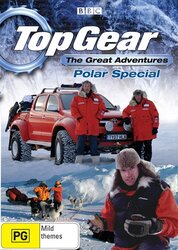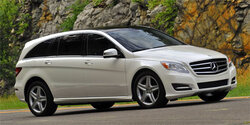Linford
Guest
The problem with the RWD sports car like the Beemers and Mercs is that they have no weight over the driven wheels, The diff will happily spin one wheel all day and feed no power to the other one (unless they come with LSD's). Wide wheels are good, but as they are low profile tyres, have little compliance with an uneven surface. It doesn't help either that they have such powerful engines producing massive amounts of torque which the average leadfoot struggles to measure out in small doses
2CV's do reasonably well offroad for what they are because they are so light, but the notion that thin wheels/tyres combinations help grip in poor conditions, is to me a bit of a bogus one. If this were actually true, they would have equipped Helen Skelton with a Roadie shod with 23c tyres than what she actually did the polar challenge on.

Likewise, when Clarkson and co went to the magnetic north pole in a car, they took this and as you can see from the tyres in this pic, they are running virtually flat to give as much grip as possible on a very low traction surface (these tyres actually have very soft compounds so flexible in low temperatures unlike a regular tyre, and are 'siped' with cuts in the tread blocks so they spread out more easily under the weight of the vehicle to give more of a surface area)

I usually go driving in my 4x4 in the back lanes of the Cotswolds when the snow hits as you usually have the roads to yourself, and last night was no exception. I did about 25 miles, and the most I topped out at where there was a layer of snow/ice on the ground was about 25mph as and when.
I caught a snow plough up which was driving from Andoversford to Seven Springs (well it was a newish tractor with plough on the front), and followed it at a sensible distance all at about 20 mph (10 car lengths or a bit more). He did a good job of clearing the road and his speed was consistent, so why would I want to overtake a snow plough or get too close to him, I have no idea what is in front of him (crashed cars, animals on the road etc) - and then somebody in one of these caught me up and then proceeded to sit about 10ft off my bumper for about 2 miles.

Honestly, I swear that some people have got more money than brains. Sure he has 4wd, but I very much doubt his tyres have anywhere near the grip levels of All terrains, and worse than that, it doesn't matter what you drive, you have mass which takes a lot of stopping when on a slippery surface. You have to respect that as if you do get caught out, you better pray that nothing is in your way - and big BHP is wasted on a slippery surface unless you are driving with studded tyres. Whatever you drive, you need to be able to stop, and not load up your tyres so much that you break traction on cornering because you are going too fast for the conditions.
There are 4x4's and there are 4x4's, and there are people who own them, and people who know how to drive them within their limitations.
I did a little bit of off road driver training a few years ago with an ex British champion rally driver (Colin Read), and his advice to me when driving around his off road course was 'always take the path of least resistance' - IE, if you do come up against a serious obstacle, can you go around it in the first instance ?
2CV's do reasonably well offroad for what they are because they are so light, but the notion that thin wheels/tyres combinations help grip in poor conditions, is to me a bit of a bogus one. If this were actually true, they would have equipped Helen Skelton with a Roadie shod with 23c tyres than what she actually did the polar challenge on.
Likewise, when Clarkson and co went to the magnetic north pole in a car, they took this and as you can see from the tyres in this pic, they are running virtually flat to give as much grip as possible on a very low traction surface (these tyres actually have very soft compounds so flexible in low temperatures unlike a regular tyre, and are 'siped' with cuts in the tread blocks so they spread out more easily under the weight of the vehicle to give more of a surface area)
I usually go driving in my 4x4 in the back lanes of the Cotswolds when the snow hits as you usually have the roads to yourself, and last night was no exception. I did about 25 miles, and the most I topped out at where there was a layer of snow/ice on the ground was about 25mph as and when.
I caught a snow plough up which was driving from Andoversford to Seven Springs (well it was a newish tractor with plough on the front), and followed it at a sensible distance all at about 20 mph (10 car lengths or a bit more). He did a good job of clearing the road and his speed was consistent, so why would I want to overtake a snow plough or get too close to him, I have no idea what is in front of him (crashed cars, animals on the road etc) - and then somebody in one of these caught me up and then proceeded to sit about 10ft off my bumper for about 2 miles.
Honestly, I swear that some people have got more money than brains. Sure he has 4wd, but I very much doubt his tyres have anywhere near the grip levels of All terrains, and worse than that, it doesn't matter what you drive, you have mass which takes a lot of stopping when on a slippery surface. You have to respect that as if you do get caught out, you better pray that nothing is in your way - and big BHP is wasted on a slippery surface unless you are driving with studded tyres. Whatever you drive, you need to be able to stop, and not load up your tyres so much that you break traction on cornering because you are going too fast for the conditions.
There are 4x4's and there are 4x4's, and there are people who own them, and people who know how to drive them within their limitations.
I did a little bit of off road driver training a few years ago with an ex British champion rally driver (Colin Read), and his advice to me when driving around his off road course was 'always take the path of least resistance' - IE, if you do come up against a serious obstacle, can you go around it in the first instance ?










 ).
).